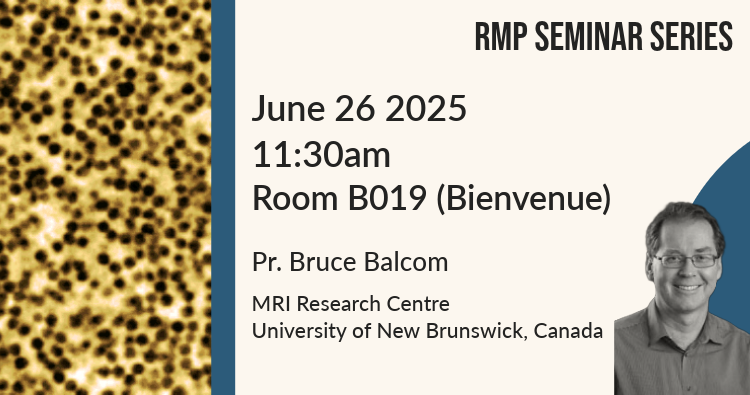
Séminaire RMP: Pr. Bruce Balcom (University of New Brunswick, Canada)
Magnetic Resonance and Magnetic Resonance Imaging of Fluids in Porous Media
Abstract:
Magnetic Resonance Imaging (MRI) is very well known as the premiere diagnostic method in biomedicine. As a spectroscopy technique, magnetic resonance (MR) is the premiere method for molecular structure determination. There is however a long parallel history of MR/MRI for studies of materials and material processes. In this lecture we will explain spatial encoding and contrast in MRI studies of materials, and material processes. Knowledge of the MR signal lifetimes is critical since these lifetimes, often termed relaxation times, control the contrast in MRI studies.
We will illustrate the above ideas through methods developed at UNB to address the challenges of MR/MRI of materials. We will include examples from analysis of shale materials, and water uptake in shales, in addition to MR/MRI of wood materials. We will discuss a new generation MR/MRI measurement based on a cryogen free variable field superconducting magnet that permits one to control susceptibility effects in 1H measurements which also permits facile measurement of 23Na, 31P, 19F, 13C and other nuclei in conjunction with 1H studies. Finally, we will introduce a new generation of low cost MR instrumentation that permits rheology measurement of complex fluids.
Bio:
Bruce Balcom attended Mount Allison University in Canada from 1981 to 1985, graduating with an honours degree in Chemistry. He pursued a PhD degree in Biophysical Chemistry at the University of Western Ontario from 1985-1990, supported by an NSERC 67 graduate fellowship. He changed his research emphasis in 1990 with an NSERC post-doctoral fellowship at Cambridge University, where he commenced studies on MRI of materials.
Dr. Balcom co-founded the MRI Research Centre at UNB following his appointment as an Assistant Professor of Physics in 1993. He was promoted to full professor in 2000, the same year he won an NSERC Steacie Fellowship (2000-2002). He has held a Tier 1 Canada Research Chair in MRI of Materials since 2002, with two renewals of the seven-year Chair. The UNB MRI Research Centre is one of the largest and best equipped MRI of materials labs world-wide. The author or co-author of close to 300 peer reviewed research publications, he has more than 35 patents awarded. His work led to the establishment of Green Imaging Technologies, a UNB spinoff company, in Fredericton 15 years ago.


